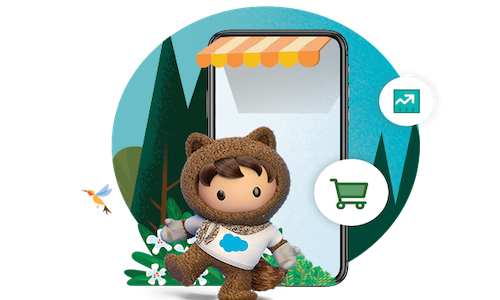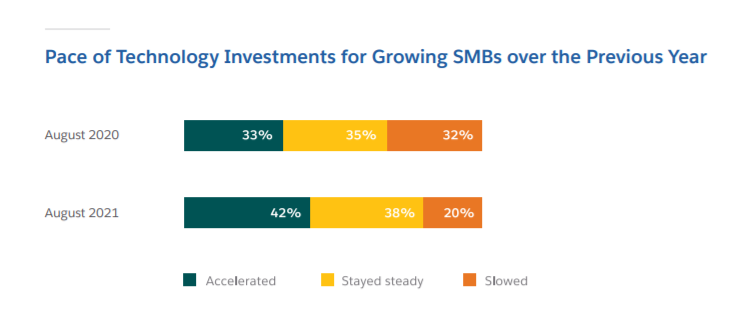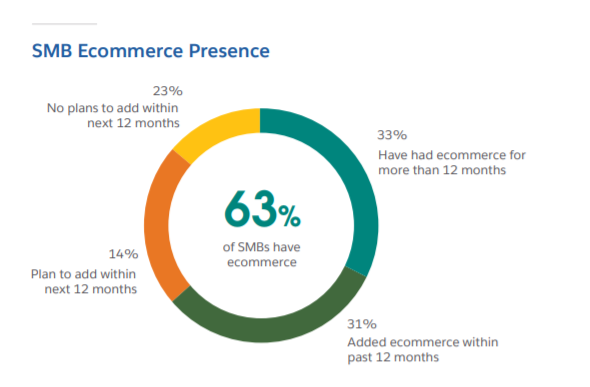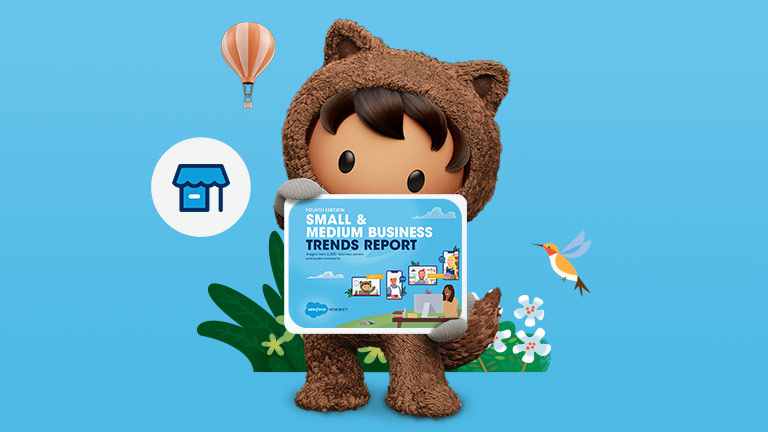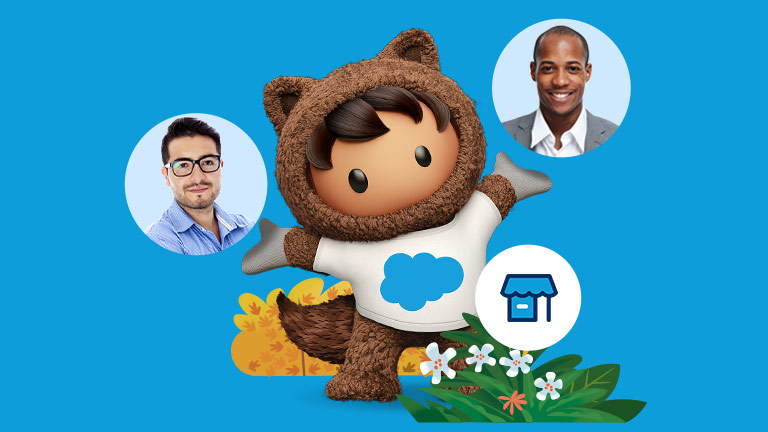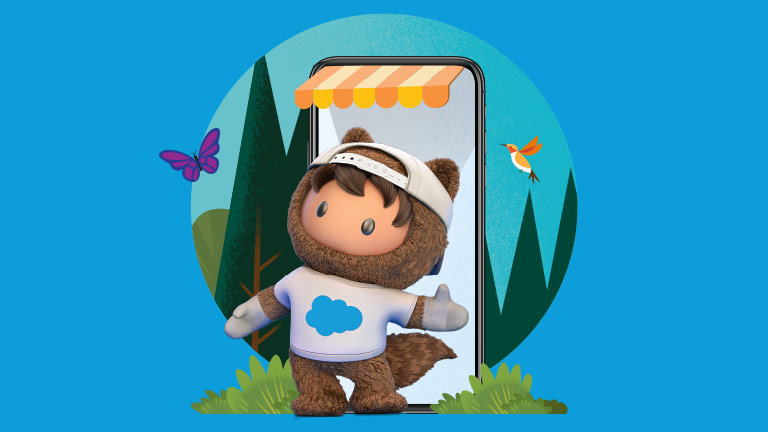Small business loyalty programs are helping SMEs keep up with the customer, whose expectations are higher than ever. Additionally, more and more organisations are turning to digitisation to nurture agility and drive engagement, while skilling up their teams and turbocharging their workforce with new technologies.
These are just some of the trends highlighted in the fifth edition of the Small and Medium Business Trends Report, which compiles insights from over 2500 business leaders around the globe.
It’s clear from the report that recent challenges have led to widespread business transformation among SMEs. 71% of growing SMEs say their business survived the pandemic because of digitisation. We’ve now entered a new frontier, where the customer comes first, and the pace of technological adoption has been accelerated.
The report reveals a landscape in a state of flux, as companies race to stabilise their business while also improving and future-proofing it:
83% of customers now expect to interact with someone immediately when contacting a company.
42% of growing SMEs have increased their technology investment in the past year.
42% of SMEs have expanded the ways that customers can reach them.
45% of SMEs have either added e-commerce in the past 12 months or plan to do so in the next year.
The digital-first world is upon us. Customer expectations for service have never been higher, and it’s never been easier for them to click over to your competitor. In this climate, building resilient customer relationships is critical. That’s where small business loyalty programs come in.
What are small business loyalty programs?
Put simply; small business loyalty programs are a great way to build better relationships by providing customers with perks. Customer rewards can range from discounts and first looks at new merchandise to free products and invites to members-only events.
When utilised effectively, small business loyalty programs add value for both the customer and the business. Ideally, these programs are unintrusive. So, SMEs will want to avoid SPAM texts and faceless email blasts and instead think highly tailored communications.
The purpose of small business loyalty programs is to drive long-term engagement. And while these programs will often incentivise customers to make purchases, they shouldn’t be pushy or too sales-y. After all, it only takes a few seconds for a customer to uninstall a loyalty app and take their business elsewhere.
The top 5 benefits of small business loyalty programs
Driving customers to make more purchases is just one of the benefits of small business loyalty programs. Here are a few other ways that SMEs can benefit from incentivising customer loyalty.
Improved customer retention. It’s far cheaper for small businesses to keep a customer than find a new one. Estimates put attracting a new customer at anywhere from 5x to 25x the cost of retaining one.
More referrals: Loyal customers are happy customers. And happy customers can lead to new referrals. By incentivising and building a loyal fanbase, SMEs can generate good word of mouth and create brand advocates.
Amplified brand voice. SMEs can use the digital space wisely by creating a loyalty app for small business. The app would showcase a brand’s voice and ethos to millions of customers that, not too long ago, could have only been reached through pricey ads.
Data-driven selling opportunities: SMEs can better understand every customer’s unique pain points and needs by personalising communications and analysing customer behaviour. They can then find ways to add value and deliver relevant experiences.
Better feedback: Digital-first consumers aren’t afraid to tell you what’s on their minds. Small business loyalty programs offer a convenient way for SMEs to get feedback from their most loyal customers, enabling them to fix problems and create new offerings.
Those are just some of the ways that small business loyalty programs can benefit SMEs. Of course, it’s just as crucial for businesses to ask how their program can help the customer. It’s the synergy between the two that make loyalty programs so effective.
How to create a great loyalty program
When looking at how to create a successful small business loyalty program, put yourself in the customer’s shoes. What would incentivise you to make purchases? How can you use the data you gather to improve the customer experience? Can you use the program to deliver unique features or better services?
Here are five things that SMEs should consider when creating a loyalty program.
What type of rewards system should be used? Rewards systems can be based on everything from earning points towards products or services to offering subscription-based rewards and perks for referrals.
How can the loyalty program create an experience, not just convenience? Value and convenience are still top priorities for customers. But look past the basics and see how your loyalty program might deliver a more surprising and rewarding experience.
What rewards should be offered? Base rewards usually include vouchers, discounts and freebies earned through purchases. But consider extending your offerings to include unique perks that could be differentiators, perhaps even through brand partnerships.
Can the program amplify your brand’s ethics? If your SME is mission-driven, make sure that mission is highlighted in your program. Most of today’s consumers want to do business with brands that have values they respect, so show them off when you can.
Can it be gamified? Simple rewards programs are great. Lots of customers appreciate the rewards they can earn and eagerly keep track of points. But some brands take it further and offer more interactive experiences, complete with gamified elements, storylines, competitions and social media engagement.
Why a loyalty app for small business is essential in the new climate
A loyalty app for small business can create significant experiences and long-lasting loyalty. And loyalty is becoming increasingly important in a post-pandemic world. A loyalty app for small business is more than a tool for customer-centric marketing; consider it a tool for delivering unique and meaningful experiences.
For instance, creating a loyalty app for small business could be an excellent way to offer exclusive products and provide real-time customer service. A clothing retailer could add a virtual changing room to their app or member-only tools for customising clothing. A food and beverage business could let users share and rate recipes made with their products and reward the most innovative with perks. All these examples offer features that bring businesses and their customers closer together.
When creating a loyalty app for small business, be creative, brainstorm and think outside the box. Don’t be afraid to make your offerings stand out while still being in line with your brand. Small business loyalty programs do more than reward customers – they reward relationships.
To see more insights from 2500+ SME leaders worldwide, download the fifth edition Small and Medium Business Trends Report here.
